 |
 |
 |
| |
Resistance to RDEA806 Requires Multiple Mutations Which Have Limited Cross-Resistance to Other NNRTIs
|
| |
| |
Reported by Jules Levin
ICAAC/IDSA Oct 27, 2008, Wash DC
W. Xu, B. Groschel, R. Straney, Z. Zhang, D. Bellows, R. Hamatake, J-L. Girardet, B. Quart, A. RaneyArdea Biosciences, Inc.
AUTHOR CONCLUSIONS
In this long-term selection study, RDEA806 provided more durable suppression against Wt and K103N viruses than efavirenz.
The pathways to RDEA806 resistance were different for Wt and K103N viruses.
Other than efavirenz activity on the K103N-containing viruses, most of the viruses selected remained susceptible to other NNRTIs.
The viruses engineered with the mutation patterns that showed high levels of resistance replicated very poorly.
The prolonged suppression of viral breakthrough and the requirement for multiple amino acid changes for high level resistance suggest that RDEA806 has a high genetic barrier to resistance.
Consistent with this in vitro study, no genotype or phenotype changes occurred during RDEA806-201, a phase 2a monotherapy study in treatment-na´ve HIV-infected individuals (UCAAC oral).
ABSTRACT
Background: RDEA806 is a novel non-nucleoside reverse transcriptase inhibitor (NNRTI) with potent in vitro activity against wild-type and NNRTI-resistant HIV-1. Phase 2a clinical trial data demonstrated robust antiviral activity in na´ve patients. RDEA806 suppressed viral breakthrough in an in vitro resistance selection study for 9 months, indicating a high genetic barrier to resistance. The genotypic and phenotypic analyses of the mutant viruses selected by RDEA806 in this resistance selection study will be presented.
Methods: Selection of HIV-1 virus resistant to RDEA806 was performed in infected SupT1 cells. The mutations identified in the RT region at the time of virus breakthrough for each drug concentration were engineered into a wild-type vector. Activity was measured using the VSV-G protein pseudotyped NL4-3.Luc.R-E- virus containing the mutation(s).
Results: RDEA806 concentration was increased to 1500 nM in the virus culture over the course of 13 months. The first consensus mutation selected, K104E, was identified after > 300 days in culture and showed essentially no loss of susceptibility to RDEA806. Other NNRTIs tested also retained maximal activity against this mutant virus. RDEA806 showed a minor loss of activity to the next virus selected, K104E-E138K-T240I, while efavirenz retained full activity. Virus with the ultimate combination contained 5 RT mutations, K104E-E138K-T240I-V179D-F227L, and had very low replication capacity. While RDEA806 lost potency against this virus, other NNRTIs showed only minor to moderate cross resistance.
Conclusions: Prolonged suppression of viral breakthrough in this resistance selection study suggests that RDEA806 has a high genetic barrier to resistance. Phenotypic analysis of selected mutations indicates that multiple mutations are necessary for loss of susceptibility to RDEA806. Minor cross-resistance to some of the mutation patterns is observed by some of the NNRTIs tested.
INTRODUCTION
The development of resistance to the most widely used nonnucleoside reversetranscriptase inhibitors(NNRTIs) limits the efficacy of these drugs. New NNRTIs with higher genetic barriers to resistance and activity against viruses with common drug-resistant mutations are needed for the effective treatment of patients carrying these mutations. RDEA806 is a novel NNRTI with in vitro activity across a broad range of NNRTI-resistant viruses and robust anti-HIV activity in infected patients. The study presented here suggests that RDEA806 may also provide a higher threshold to resistance, with the potential for more durable suppression of the virus in patients.
METHODS
Selection and determination of RDEA806-resistant mutations. SupT1 cells were infected with wild-type (wt) or K103N HIV-1 in the presence of the EC50 concentration of RDEA806 or efavirenz (EFV). At each virus breakthrough (massive synctia formation), the concentration of inhibitor was doubled. Genotypic analysis of the emerging viruses was performed by amplification of the pro-viral DNA and subsequent sequencing of the RT region in 10 or more individual PCR clones recovered at each breakthrough point.
Construction and testing of NNRTI-resistant viruses. Clinically prevalent NNRTI-resistant mutations and the RDEA806 mutations were constructed into the HIV-1 molecular clone pNL4-3.Luc.R-E-. A VSV-G protein-psuedotyped lucerifase-expressing HIV-1 was used to determine the antiviral activities. The EC50 values were determined by non-linear regression using XLfit4.
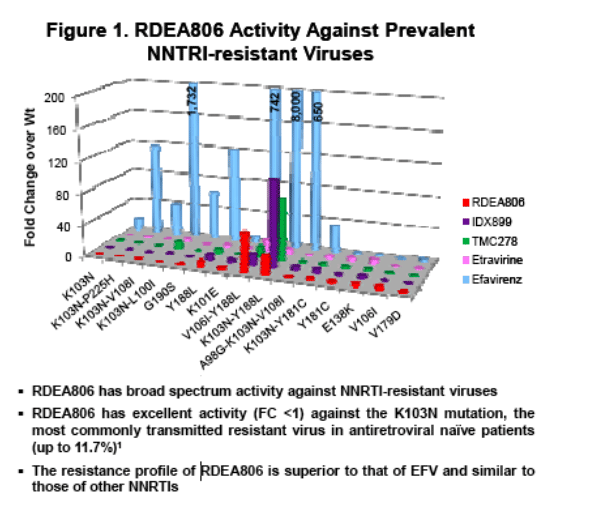
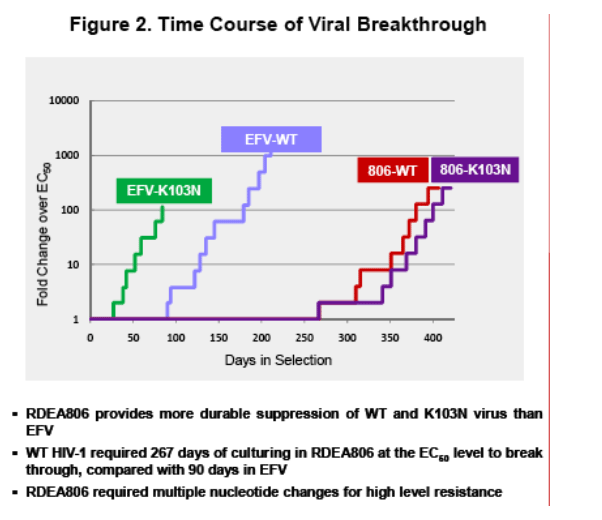
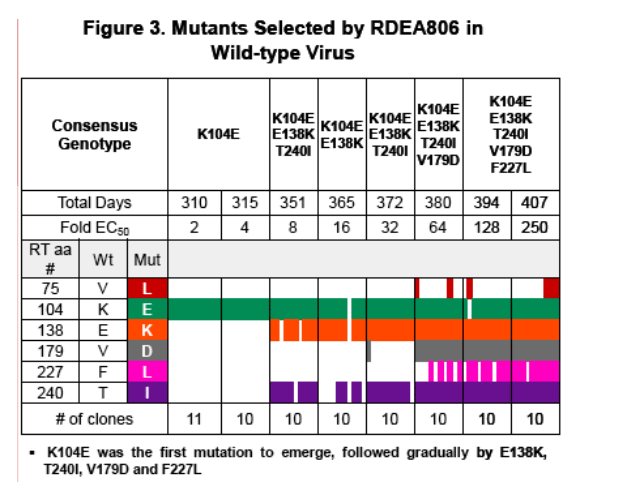
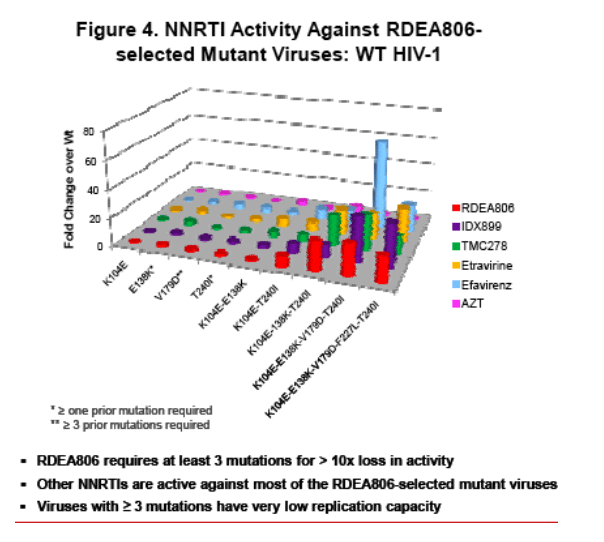
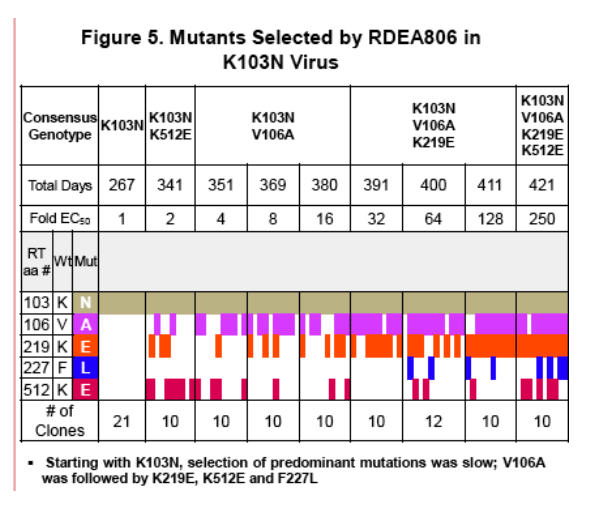
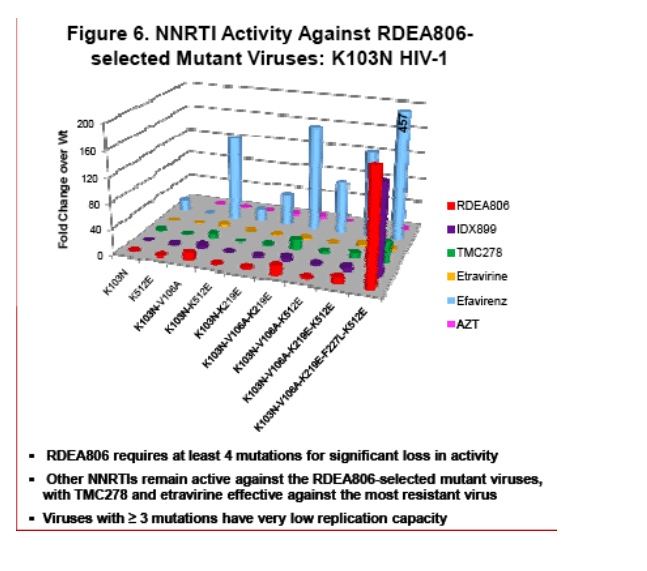
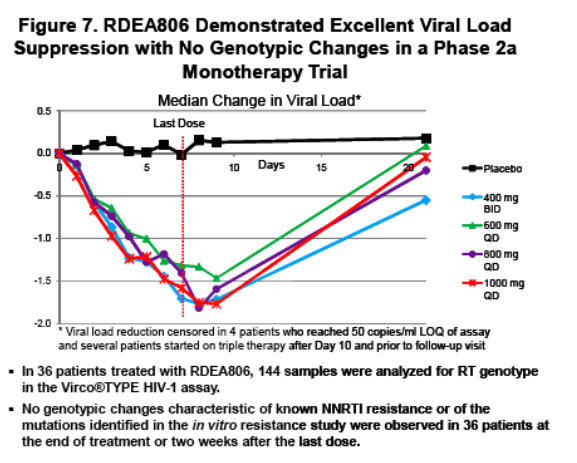
|
| |
|
 |
 |
|
|